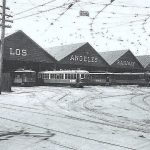Big MTA “BS” (Part Two)
By Ralph Cantos
LAMTA PCC #3148 prepares to depart 6th & Main Street elevated station for a southbound trip to Long Beach. Except for the very first northbound test run from Long Beach to LA in the “forward position,” all the northbound trips were made in the “reverse position.”
At 9th & Hooper on that first “test run,” the 3148 was run into the 8th Street Yard, where it was “Y”-ed and then run in reverse the last mile or so to the 6th & Main Station, its makeshift rear headlight aglow. So, from then on, the southbound trips were operated in a normal fashion. There being no “Y” or loop at Long Beach, the runs back to LA were done in reverse all the way to the 6th and Main Street station.
All this “BS” in my opinion was for NOTHING. PE’s beautiful double end PCCs were gone by this time, and Toronto’s TTC had picked up every available surplus PCC in America (except for PE PCCs). There were NO “used” PCCs to be had. The TTC had gotten them all. And the MTA was not about to build a costly reverse loop at 6th & Main Station. With the “test runs” completed, the standard gauge trucks were returned to the SF MUNI, and the 3148 returned to its home turf on the P line. Little more than a year later, the Long Beach line was abandoned.
With the demise of the Long Beach Line, the MTA was no longer held hostage to the PE 6th & Main Street Terminal. So the terminal with its nice passenger amenities was closed and all of MTA’s “modern” bus operations moved to an empty parking lot about a block away. Bus passengers were now left to fend for themselves, sometimes in less than ideal weather conditions, until the BIG UNION BUS Terminal was built on the site the old elevated station. And that too was abandoned in time. After about eight years of this LAMTA fiasco, the Southern California Rapid Transit District was created to replace the LAMTA. The SCRTD was in turn replaced by today’s LACMTA, and the monumental task of rebuilding LA’s once great commuter rail system began all over again. One big Hell of a “Humpty Dumpty” to say the least, at a cost of hundreds of billions of dollars, simply to recreate what we once had. If I had not seen all this BS with my own eyes, I would never have believed anything like this could have happened, but it did and it was a DAMN SHAME that it was allowed to take place.
Ralph Cantos Collection





Is Hopper a typo? Should be Hooper? Just curious.
Thanks, Chris – good catch! – Ed.
Hi Ralph:
Excellent work on both your articles. It is such a darn shame that so many cities abandoned their energy efficient, environmentally friendly electric transit systems (still being done today) when a few measly dollars invested could have saved billions of dollars in wasted hours stuck in traffic and on health problems caused by pollution. A little vision by public officials would have saved this important mode of transportation and possibly many lives, certainly billions in taxpayer dollars. Back then the vision was the automobile and all was destroyed in order to serve the car.
I rode the gorgeous PCCs in Buenos Aires and even there the policy was to tear up electric transportation. The cars had been intended for Buenos Aires’ giant urban trolley network, but as they were being shipped south, the decision was made to close down this extensive system with over a thousand cars — it was done in just one year! The PCCs were then sent to the suburban Urquiza line. Sadly, they didn’t work out. The branch line they served was immediately closed after they were withdrawn from service. A crime that was also known as the car-friendly policy of the government.
Again, good work on your piece.
Regards,
Tito
According to Interurbans Special 43, the standard gauge trucks were borrowed from SF Muni 1024. This car still exists, ironically as one section of a “kitbashed” double-ended PCC belonging to the Tahoe Valley Lines PCC Railway. 1024 and 1035 were spliced together to make a double-ender, but I doubt that this “Frankentram” has been tested. Even though the cars came from Muni, the City cannot use this creation on the “E” line and its fate is unknown.